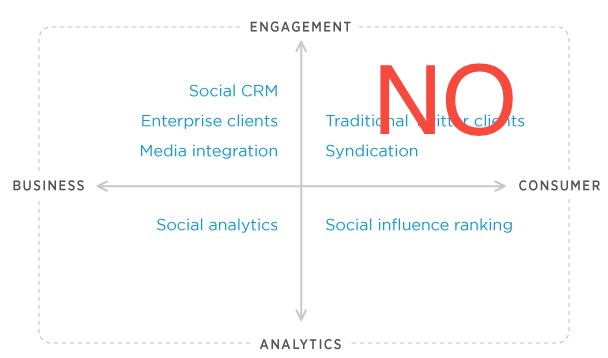Twitter’s Michael Sippey announced a bunch of upcoming changes to the company’s API in a blog post today. We’ve already summarized the post, but here’s the big picture: Things are about to get tougher for developers of traditional Twitter client apps.
A lot of the new restrictions come under the category of “Developer Rules of the Road.” For example, developers will now have to follow the Display Guidelines rather than treating them as, well, guidelines. Also, applications that are pre-installed on mobile devices need to be approved by Twitter first.
Perhaps most significantly, apps that require more than 1 million individual “user tokens” will now have to work directly with Twitter. If you’re accessing certain services, such as the home timeline, that are “typically used by traditional client applications”, the threshold is 100,000 user tokens. If an existing app is already over the threshold, it can continue to operate, but once it doubles the user count that it has today, “You’ll be able to maintain your application to serve your users, but you will not be able to add additional users without our permission.” (Emphasis mine.)
Why all the new restrictions? Well, it sounds like Twitter isn’t really interested in supporting services that compete with its own client apps. That’s something the company has said before, and it’s something Sippey basically says again in the blog post, accompanied by a handy-dandy chart, which I’ve included at the top of this post. (Uh, the red letters are my addition.) If you’re in upper left, lower left, and lower right quadrants, you’re groovy. If you’re in the top right … not so much. Or at least, Sippey says the company is trying to “limit certain use cases” in that area. He writes:
In the upper right-hand quadrant are services that enable users to interact with Tweets, like the Tweet curation service Storify or the Tweet discovery site Favstar.fm.
That upper-right quadrant also includes, of course, “traditional” Twitter clients like Tweetbot and Echofon. Nearly eighteen months ago, we gave developers guidance that they should not build client apps that mimic or reproduce the mainstream Twitter consumer client experience. And to reiterate what I wrote in my last post, that guidance continues to apply today.
To be clear, the post seems to be giving a thumbs up to services like Storify and Favstar, but not to the traditional Twitter clients.
As Sippey says, Twitter has been moving in this direction for a while. But to paraphrase Hunter Walk, this looks like the moment when the company rips off the Band Aid. It’s going to hurt some developers now, but hopefully it’s not just drawing out their pain.































Comment